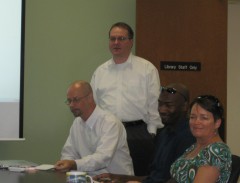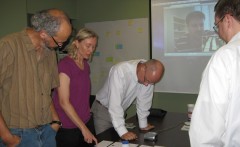The TDL has completed a key phase of development on the Texas Learning Object Repository (TxLOR), performing a demonstration of its first iteration of the system to UT TeleCampus representatives on Tuesday.
UT TeleCampus (UTTC) is leading the TxLOR project, with funding from the UT System Office of Health Affairs and the Texas Higher Education Coordinating Board. UTTC has contracted with the TDL to provide technical development services for the repository, which will store and disseminate digital objects – including videos, quizzes, lesson plans, and images – used in teaching and learning.

TDL staff Pete Nürnberg and Otto Fox with Junius Rowland and Terry Barksdale of UT TeleCampus
For the TxLOR project, the TDL development team is using an Agile development methodology called Scrum, in which developers work in short development “sprints.” At the end of each sprint, TDL staff demonstrate a workable product to the TxLOR product owner, project manager Junius Rowland of UTTC.
At the start of the first TxLOR sprint on August 17, Rowland and the TDL development team worked together to create and prioritize a series of “user stories,” the Scrum term for system requirements. Developers then worked for three weeks to create a working model that fulfilled a designated set of the user stories. On Tuesday, developers revealed the results to Rowland and other project stakeholders at a demonstration held at TDL offices in Austin.
In addition to Rowland, UTTC Director Rob Robinson was present along with Michael Anderson and Terry Barksdale, both of UTTC. TDL developers who worked on the sprint are Dan Galewsky, Otto Fox, Jade Lindquist, and William Sidney, as well as TDL chief technology officer Peter Nürnberg.
“By working in short development cycles, we can create a working system rapidly,” said Nürnberg. “We also stay flexible and attuned to UTTC’s needs for TxLOR, since they can provide feedback to our developers at regular intervals.”

TDL developers plan for second TxLOR sprint
The first iteration of the TxLOR model includes login and registration functionality, as well as the ability to add, search for, comment on, and download learning objects. Future development sprints will enhance and add functionality to the system. The finished TxLOR will feature a submission and review workflow system built in Grails, an open-source Web application framework, and will use a DSpace repository for dissemination of the learning objects.
Current development plans call for two additional three-week sprints, with the final sprint concluding in mid-October.
The TDL is working in conjunction with several other TxLOR working groups, including those designing metadata standards for the repository, as well as policy guidelines and a definition of the submission workflow.
You can find out more about the TxLOR project in the Texas Digital Library wiki and the TxLOR project wiki. You may also contact the TDL with questions at info@tdl.org.
